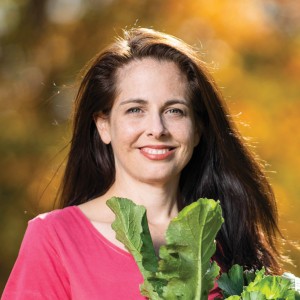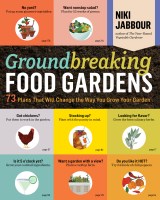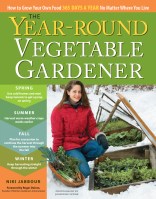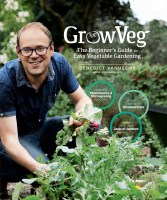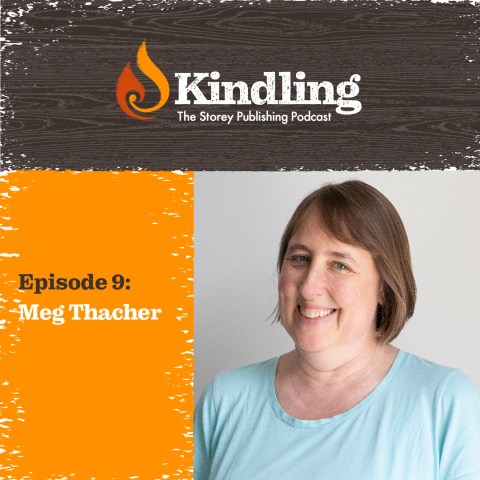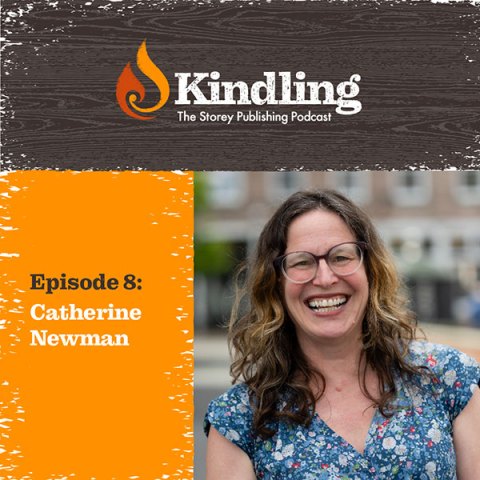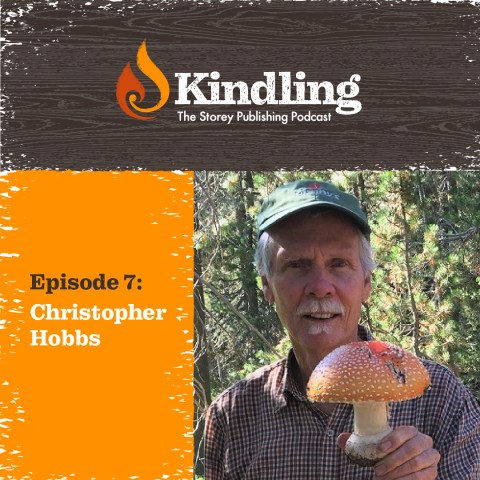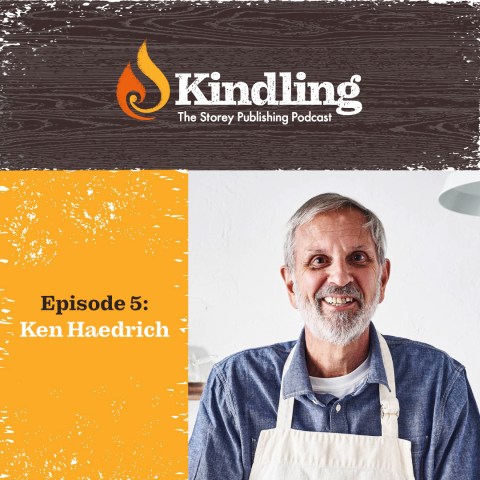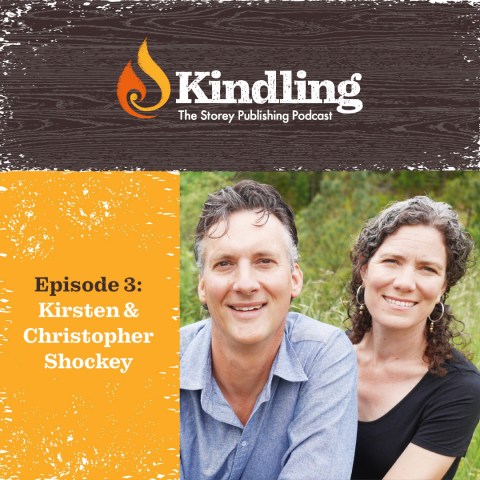Kindling Podcast Episode 4: Niki Jabbour
Tune in as Storey acquiring editor Carleen Madigan speaks with Niki Jabbour about her new book, Growing Under Cover.
In this episode, gardening guru and best-selling author Niki Jabbour (The Year Round Vegetable Gardner, Niki Jabbour’s Veggie Garden Remix, Groundbreaking Food Gardens) covers a variety of gardening topics, from buying seeds to growing in a polytunnel to the many, sometimes unexpected, benefits of growing under cover.
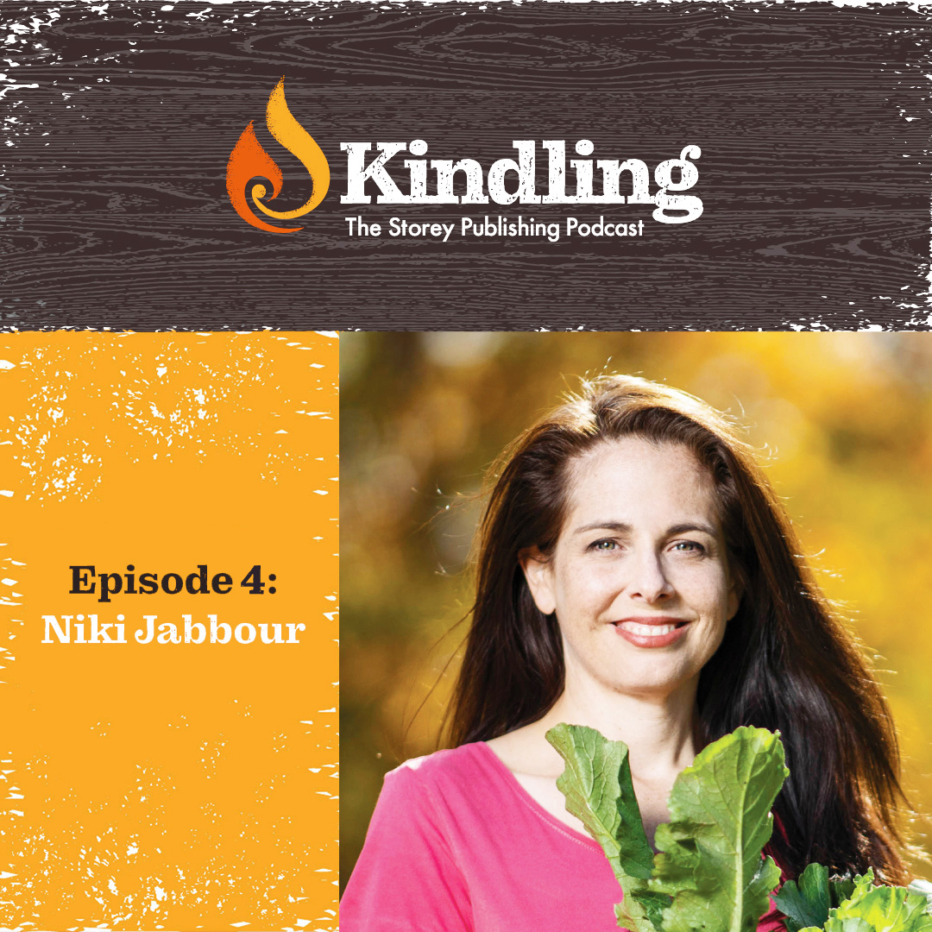
This episode of Kindling: The Storey Publishing Podcast can also be found on podcast platforms including Spotify and iTunes. If you enjoyed this episode please be sure to leave us a rating and review.
Full Podcast Transcript
Deborah Balmuth:
This is Kindling, The Storey Publishing podcast, where we explore the spark that ignites a deep-rooted passion for sustainable living. I’m Deborah Balmuth, Storey’s publisher. From growing organic food and making herbal remedies, to fermenting, weaving, and raising chickens. The authors we’ll meet will empower you with the skills and savvy they’ve gleaned from years of hands-on experience. In each episode of Kindling, you’ll learn what fuels these authors’ excitement. And what they love most about creating books that share their expertise and enthusiasm with the world.
Have you ever dreamed of creating your own garden, or of expanding the garden you already have? In today’s episode, we’ll meet Niki Jabbour, best-selling author of The Year-Round Vegetable Gardener, and the forthcoming book, Growing Under Cover. She recently spoke with her editor, Storey’s Carleen Madigan, to share expert advice on creating a food garden that offers a bounty all year round.
Carleen Madigan:
Hi Niki, thanks for chatting with me today.
Niki Jabbour:
Hey, Carleen, it’s great to talk. It’s been a while.
Carleen Madigan:
It has. Why don’t we start by having you tell the listeners a little bit about where you garden, and what your garden looks like?
Niki Jabbour:
Well, I am in zone 5b in Nova Scotia, Canada, and in Halifax. So that is the largest city in my province, and we are so far east, that… Nova Scotia is almost an island, and it is joined to the land by New Brunswick. But if you were in New York City and drove, it would take you about 12 hours to get here. Because of the ocean, we have winters that are, I mean, cold and long, but we don’t generally have too, too much snow. It depends, I guess, from year to year, and with global warming, things have certainly shifted. So I garden in this area here, and I harvest every day of the year from my garden, even in winter. Traditionally, people would always say, “did you get your garden in yet?” in late May. But for me, my garden is always in, I’m always harvesting a wide variety of vegetables. In winter, of course, I’ve got the cold frames, as you know. As well as mulched beds, mini hoop tunnels, and a polytunnel. So there’s not a day of the year we don’t have some delicious, organic, homegrown food to harvest.
Carleen Madigan:
That’s pretty awesome. How many beds do you have? I know you recently did a big gardening renovation, and I try and count them sometimes. “How many beds does Niki have in her garden?” And they’re quite high, raised beds, right?
Niki Jabbour:
They are. And I sometimes think, “How many beds do I have?” because I’m always adding more. Yeah, it’s actually been five years since I renovated the garden. And the main catalyst for that was Veggie Garden Remix. I knew I was writing this new book, and I knew I wanted to update my garden. And it was time, so I totally renovated. We added 20 raised beds that are either four by eight, or four by 10, depending where you are in the garden. And they’re all 16 inches tall. My existing soil in that spot was quite poor, so I didn’t want to have low beds, I wanted high. Plus I love sitting on the edge of them, it’s just nice to work, and perch on the edge of your beds, and work there. We’ve got lots of tunnels, and trellises, so it’s a magical place to me.
But then I also have a bunch of little beds scattered around. There’s big ones in my polytunnel, there’s straw bales, beds that are formed straw bales, and just piles of old straw that I grow squash and cucumbers in. And so I have a lot of different beds scattered around here and there to grow things in, but you know what? I love the garden so much. It’s my happy place, even though it’s black fly season right now. And I’m spending lots of time up there, just getting things ready for the spring season. It’s a wonderful time of year.
Carleen Madigan:
You have an awful lot of great places to buy plants near you in Nova Scotia. I mean, do you tend to buy most of your plants locally, or do you get a fair number of things that you start from seed, from companies online?
Niki Jabbour:
It’s a wide variety. I order lots of seeds, far too many seeds, really, every January. I have no self-control when it comes to seeds. So I get a lot of different varieties from companies in my own area, across Canada, and the US, and beyond. I try to come up with a plan of what I can grow and what I want to grow. And then I also try to think about, “Well, I want these for spring, these lettuces, for example, but then what am I going to replace them with when they’re done?”
So then I try to think of the garden in four seasons, so that I order all the seeds I need for the entire year. Because companies run out, and if you decide to order more seeds in June, you might be out of luck. We do have some wonderful nurseries here in Nova Scotia. A lot of them are offering a lot of different things, like I’ve been growing cucamelons for, I don’t know, 15 or plus years. And now pretty much every nursery carries cucamelon seedlings, as well as ground cherries, and…
Carleen Madigan:
Oh, that’s great.
Niki Jabbour:
Well, a lot of them told me they were inspired by Veggie Garden Remix, which is amazing. So a lot of them carry a lot of plants, but this is an odd year. This is the pandemic year, and there’s no hotter ticket item in Nova Scotia, or beyond, this year, I think, than seeds and plants. So a lot of nurseries are running out this year, so I’m glad I started most of my own seeds myself.
Carleen Madigan:
Yeah. Have you been getting a lot more questions from new gardeners, or people who are just getting into this because of the pandemic?
Niki Jabbour:
I literally can’t keep up. I’ve always tried to keep up with questions on social media. I get texts from friends, and family, and, “My neighbor wants to know this.” And I try, but I can’t anymore, I just have not been able to keep up. I’m currently going about 14 hours a day now with the commitments that I have, and the rest of my hours would be soaked up with questions. And it’s not usually one, it’s a series of questions. So I try so hard, and then I take the questions I get from people, and then I try to turn those into articles. Whether it’s a newspaper column, or a magazine article, or a blog post. So that I can at least answer the question that a lot of people are asking me, in a way that most people can see it. I hope. So in the radio show, we tackle those questions and topics too. So even if I can’t answer every individual question now, I’m trying to address the broad scope of what they’re asking. So that more people will benefit too.
Carleen Madigan:
That’s awesome. What are you especially excited about growing this year?
Niki Jabbour:
Oh my gosh, yes. I’m excited about everything, honestly.
Carleen Madigan:
Everything!
Niki Jabbour:
Everything. I mean, I love every aspect of the garden. I mean, I love the actual outdoor garden, but I also love in the polytunnel, which is a totally different environment. And being in there, and tending the tomatoes that grow up the trusses, and their strings. And pinching out suckers, and watching the cucumbers grow every day. It’s so awesome to have a sheltered space to grow, and it increases my garden yield almost twofold, really. But I’m also excited to try some new to me varieties. Emma Biggs, who co-wrote Gardening With Emma, she sent me some tomato seeds, which I’m excited to… They’re growing well, I’m going to put them in the garden, hopefully, today or tomorrow. And I’ve got the gourds coming along as well. I’ve got just a lot of really interesting, new to me varieties. That might be heritage or new hybrids, but it’s always fun to try new things.
Carleen Madigan:
I heard recently that there have been a few people talking about like, “Oh, Niki talking about grocery store gardening, or how to use up things from the grocery store.” And I noticed in the basil article, that you talk about even if you just buy a pot of basil from the grocery store, you can take cuttings from that. So was that one of the things that came out of a question from a gardener?
Niki Jabbour:
Yeah. I mean, I’ve been getting asked a lot about the grocery store gardening, as you mentioned, “Can you regrow vegetables you buy at the grocery store, or that you have in your fridge?” And you can start some of them again in water, or planting them up in some soil. You’re not going to grow a whole new giant head of lettuce, or… You know what I mean? You’re not going to be able to grow a whole head of garlic in your windowsill, and I think it’s important to tell people that. For me, it’s more fun, and to see what I can do with my plants. But you certainly, rooting herbs, like basil, and many other herbs, like mint, my goodness. Those herbs root in about seven to 10 days, if you put them in a glass of water. So super quick and easy to do.
And I’m always pinching back my garden basil, because the more you pinch, the more you harvest, the more you get. The plants respond by sending out fresh side shoots. So those extra cuttings, if you’re not going to eat them right away, you could dry them, of course, but I just stick them in water. And then in about a week or so, I’ve got new roots. I’ll pot them up, and then I’ve got a second crop of basil to last me into late summer and fall. And let’s be honest, Carleen, can you have enough basil in the garden?
Carleen Madigan:
No. No, there’s never enough. And I never have enough basil.
Niki Jabbour:
Right?
Carleen Madigan:
So I am definitely going to take cuttings this year and give it a try. Yeah.
Niki Jabbour:
And those are the two things, you can never have enough basil, and you can never have enough compost. I think every gardener will agree with that.
Carleen Madigan:
Yes. Yeah, it’s true. And garlic, I will add garlic to that.
Niki Jabbour:
Oh, I will fully support that.
Carleen Madigan:
I have been watching the weather. I’m going to add garden covers to that, you can never have enough of also. Because I don’t know about you, but around here we’ve been having some kind of crazy weather lately. So my plants are freaking out, and of course, I had already planted a few things. So I started reading through the manuscript again, of your book coming up, Growing Under Cover. Has the weather been this crazy in your area, and was this part of your inspiration for writing Growing Under Cover?
Niki Jabbour:
Yes. I mean, I live in the Northeast. Your weather comes to me about a day, a day and a half after you’ve had it. So everything you’ve described is the exact same for us. I mean, it has been so hot the past couple days, but we did have snow just a couple weeks ago. I was just looking ahead at the long range, and it looks like Monday night we might get a frost. But again, I’m actually putting my warm season crops in, because I am an under cover gardener. And I know you’re an under cover gardener too. And I haven’t put all my covers away yet. I’m still have my row covers in the garden, I still have my plastic sheeting, and I still have little hoops everywhere in the garden. Just because it makes it super easy to pop them over top the bed of tomatoes. I just clamp them on, and then I don’t worry about it. I know that those tomatoes are going to be fine, even if we do get that light frost, not a big deal.
And you don’t have to spend a lot of money. With garden covers, you can use a lot of upcycled items like a bucket, for goodness sakes. Anything that’ll cover your plant temporarily in the event of a frost, or a hailstorm, or a downpour, is something that’s going to protect your plants and be really effective. So you don’t have to spend a lot of money, but even simple covers can make a huge difference in your garden. And I think that’s what really taught me how to become a year-round vegetable gardener. I was growing cold-hardy crops like arugula, and I thought they were done by fall. And they kept on going, even under snow. So I quickly realized if I covered them, and created a little bit of shelter, a little microclimate, we could harvest that all winter long. So it’s been a long learning session for me. I’ve been doing this for about probably 15 or 16 years, but it’s the only way to grow food at this point. And what’s exciting is I don’t think that’s a niche anymore. I think most vegetable gardeners are using covers of some type.
Carleen Madigan:
So talk a little bit about the different covers, because you just named off some of them. I’m not sure everybody will know what a mini hoop tunnel is, for example. Most people might know what a cloche is, even just putting a bucket over a tender plant, I would call that a kind of temporary cloche. But what are some of the other covers, and what are some of the benefits of using them, aside from weird weather patterns?
Niki Jabbour:
So a cloche is very basic. You have the traditional French cloches, which are these beautiful glass jars, bell-shaped jars. And I used to have a couple of those, but then every once in a while, I’d step on the edge, and they would crack. So I don’t use glass cloches in my garden anymore. I’ll use plastic milk jugs, with the bottom cut out, water jugs. I’ll get them from friends, people save me items like that. I’ll use plastic cloches you can buy from your garden centers, an old bucket in the case of incoming bad weather. A mini hoop tunnel is just a small tunnel with, I usually use half-inch PVC conduit bent over my bed. But I also have a metal bender, so I can bend metal hoops, which last, of course, forever.
And I cover those with a row cover, or a clear sheet of plastic, to create these mini-greenhouses that just create a microclimate around your plants. But cold frames, which is essentially a bottomless box with a clear top, captures that solar energy as well. And again, creates that lovely little warm area around your plants. So that’s an easy way to grow food too, but you’ve also got big covers. Greenhouses, polytunnels, domes. I mean, there are so many different types of covers you can use in your garden, just to grow more food, and grow it better. Because it’s not always about the weather, as you know. Sometimes it’s about deer, which I see in my garden all the time. And Carleen, yesterday, I went up to the garden and I saw something out of the corner of my eye. And I looked over, it was a bunny just standing up on his hind feet, looking at me, head cocked to the side.
And I’m like, “I’ve never seen a bunny by my garden before, now I’m totally terrified.” So using garden covers, right? Using garden covers, like I could have hoops, those PVC hoops that I use for making mini-greenhouses, mini hoop tunnels. But I could cover them in bird netting, or insect barrier, or something, chicken wire, and that’s going to keep deer out, and bunnies out. And other pests, like even birds, or groundhogs. Or you can get insect barrier fabrics to put over top hoops. If you’ve got Colorado potato beetles that always attack your crops, or cucumber beetles, or flea beetles. There are so many different types of insect pests. So for me using garden covers isn’t just about the weather, often it’s more about protecting my vegetables from hungry critters. So they can be very effective that way too. Yeah.
Carleen Madigan:
Well, I think your new book is going to have all kinds of great advice for people. And I have certainly enjoyed working on your past books also, and getting to know your family, and your kiddos. And they seem like they have always been really involved in the garden. And is that something that you really encouraged in them, or that they really took to naturally? I mean, did they just love vegetables when they were growing up?
Niki Jabbour:
A vegetable garden is one of the best things you can do as a family project, I think. And it doesn’t have to be big, you could just give each kid a container on a sunny deck. Or you could put in a four by eight-foot family raised bed, or a couple raised beds if you’ve got space, and plant some of your kids’ favorite vegetables. And grow cool things like the cucamelons, like lemon cucumbers, like black cherry tomatoes. Plant some different things, purple beans. And I think you’ll engage kids in their natural world. You’ll show them a bit where food comes from, and maybe, just maybe, they might eat their vegetables. And it’s exciting to see the next generation pick up that baton, and run with it, and become a gardener.
Carleen Madigan:
And it sounds like you have also, well, learned a lot of new vegetables, I guess, from your husband’s family. From Danny’s family, who is from Lebanon. What are some of the things that you’ve started growing as a result of becoming familiar with that cuisine?
Niki Jabbour:
I learned when we started dating, that family is everything in Lebanese culture. And food and family are just, they go together, like just always together, food and family. And the food, so good, and so fresh, and so delicious, and so much. And that’s really what inspired me to write Veggie Garden Remix, was the fact that I wanted to grow vegetables and varieties that my mother-in-law, and my family would recognize from their mountain village just outside Beirut. But that they didn’t have here. So things like cucuzzi, which is an edible gourd, also called snake gourd. So we harvest them young, when they’re about nine to 12 inches long, and use them like a summer squash. But they will get up to four or five feet long too, and you can use them then like a decorative gourd. But also growing the luffa gourds, so many of the Lebanese tomato varieties. Emma Biggs sent me seeds for Lebanese mountain tomatoes, which are up to three pounds, and it’s the most beautiful tomato ever. My mother-in-law hugs them before we eat them, she loves them so much. But then in Lebanon too, we were there a couple summers ago, and every 500 feet on the road is a little vegetable fruit stand. Just filled with piles of beautiful, fresh, homegrown produce. And mekti, which is a Lebanese cucumber. Now botanically, it’s a muskmelon, like an Armenian cucumber. But this is similar to that, but they’re just a little more tender, and they’re so delicious. So I have seed for those, and I’ve shared them with the seed companies around Nova Scotia. And they’re shipping them across Canada, gardeners everywhere now. Yeah, there are so many vegetables to grow, and that’s all in the Veggie Garden Remix, of course, but there’s just so much out there. I think we can escape our comfort zones in the garden, and try something new.
Carleen Madigan:
Yeah, I think that’s a great thing for people to know. That they don’t have to just keep growing the same things they’ve been growing, and that their parents grew, and their grandparents grew. To branch out a little bit, and talk to people who are around them, and learn new things. Is there a relatively large immigrant gardening community in Nova Scotia? Or, as I know, Canadians call immigrants New Canadians, which I think is the best term ever. Is there a relatively large New Canadian gardening community there?
Niki Jabbour:
Huge. I mean, it’s huge. And I mean, it’s across Canada. In the past couple of years, it’s been a whole lot of Syrian New Canadians. And they bring with them their traditions, their gardening techniques, which sometimes are a little bit different. Whether they’re free-formed raised beds, sometimes they have a lip around the raised bed, sometimes they sink them down into the soil more. It just depends on the culture. So they bring their traditions, their tools, their varieties, the things they like to grow. And then they show us how to grow them and how to eat them, so it’s fantastic. There’s community gardens that have popped up from coast to coast in Canada, for a lot of our New Canadians to garden in. Because many of them, when they first come here, they live in apartments, so they need a place to garden.
And of course, they’re supported by the communities, a lot of the seed companies and stuff too will help them out a bit. And they bring, a lot of times, their own new ideas, and new foods, so it’s been fantastic. And it’s so fun talking to some of these folks who are so excited about having a place to garden and grow some food for their family. All they just want to do is talk to you about it, and show you how they do it, and what they like to grow. And it’s infectious, their enthusiasm, so it’s fantastic.
Carleen Madigan:
That’s amazing. And did you get to see any gardens when you were in Lebanon when you were visiting?
Niki Jabbour:
Yes, I did. And it’s so interesting how they garden. I mean, I have a degree in history as well as horticulture, so I am all about the history of being there. And we went to places like Baalbek, and these ancient areas, it was incredible. But everywhere you go, I mean, you go from sea to the mountains in just an hour. It’s a small country, and has so many different environments. It’s terraces. The whole land is terraced with these ancient, I mean, sometimes they’re a thousand-year-old stone terraces, where people are still growing vegetables. Still growing olive trees, still growing figs, still growing all of these fruits and vegetables. And to me, I mean, it’s just, in Canada, we don’t have thousand-year-old gardens where you have all these ancient plants.
But a lot of people grow in containers as well, but they don’t go to the garden center and pick up a bag of potting mix. They’re using garden soil, there are many with compost. A lot of people are composting, and they’re using whatever they can get for containers. Which isn’t traditionally the plastic kind we use here in North America, or fiberglass ones, they’re using old bathtubs. They’re using buckets with holes drilled for drainage. They’re using anything that they can upcycle and recycle into a container. And then you look at these gardens and they’re just so lush, with these beautiful cucumbers, and tomatoes, and chickpeas, and so many different things. So they certainly garden in interesting ways.
Carleen Madigan:
Well, that is always so cool to see how people garden in different countries, or different regions of the world. And, well, I think that’s a good lesson for people to take away. Raised beds, garden covers, take care of the soil, those are some key things. Now that I’ve just given three pieces of advice to listeners, but if you could give just one piece of advice to someone starting their first garden, as so many people are right now, what would that advice be?
Niki Jabbour:
Start small, it’s always my advice to new gardeners. Oftentimes people will email me, or message me on social media and say, “I just rototilled an area like 40 by 50 feet for my first garden.” And I’ll be like, “What?” It’s going to be a chore. And the last thing I want is someone starting a new vegetable garden and feeling it that it’s a burden. Because it should be fun, it should be something you’re enjoying, and so start small. One four by eight raised bed the first year. After a year or two, if you’re liking what you’re doing, you could do another raised bed, or you can start in containers. The easiest thing to grow in containers is herbs. Plant up some parsley, and thyme, and oregano, basil in a pot on your deck, and just use them all the time. That’s the easiest way to get started in food gardening.
Deborah Balmuth:
That was Carleen Madigan speaking with Niki Jabbour. Author of The Year-Round Vegetable Gardener, Veggie Garden Remix, Groundbreaking Food Gardens, and Growing Under Cover. To learn more about Storey Publishing’s books and authors, visit storey.com, that’s S-T-O-R-E-Y.com. And if you have questions or comments about what you hear on Kindling, let us know. You can email us at feedback@storey.com. That’s it for this edition of Kindling, coming to you from the Berkshire Hills of Western Massachusetts. I’m Storey’s publisher, Deborah Balmuth. Thanks for listening.
KINDLING IS PRODUCED BY SHEIR AND SHIM, LLC.
Learn More
Increasingly unpredictable weather patterns and pest infestations are challenging today’s vegetable gardeners. But best-selling author Niki Jabbour has a solution: Growing Under Cover. In this in-depth guide, Jabbour shows how to use small solutions like cloches, row covers, shade cloth, cold frames, and hoophouses, as well as larger protective structures like greenhouses and polytunnels, to create controlled growing spaces for vegetables to thrive. Photographed in her own super-productive garden, Jabbour highlights the many benefits of using protective covers to plant earlier, eliminate pests, and harvest a healthier, heartier bounty year round. With enthusiasm, inventive techniques, and proven, firsthand knowledge, this book provides invaluable advice from a popular and widely respected gardening authority.



